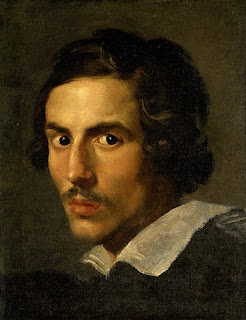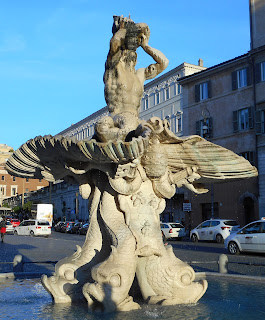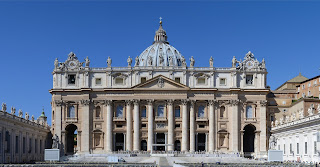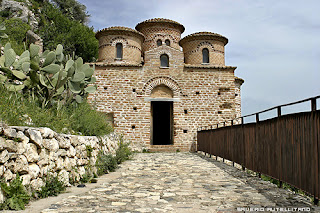Pontiff whose extravagance led to disgrace
 |
| Caravaggio's portrait of the future Urban VIII |
Urban VIII – born Maffeo Barberini – was a significant
patron of the arts, the sponsor of the brilliant sculptor and architect Gian
Lorenzo Bernini, whose work had a major influence on the look of Rome.
But in his ambitions to strengthen and expand the Papal
States, he overreached himself in a disastrous war against Odoardo Farnese, the
Duke of Parma, and the expenses incurred in that and other conflicts, combined with
extravagant spending on himself and his family, left the papacy seriously
weakened.
Indeed, so unpopular was Urban VIII that after news spread
of his death there was rioting in Rome and a bust of him on Capitoline Hill was
destroyed by an angry mob.
His time in office was also notable for the conviction in
1633 for heresy of the physicist and astronomer Galileo Galilei, who had
promoted the supposition, put forward by the Polish scientist Nicolaus
Copernicus, that the earth revolved around the sun, which was directly contrary
to the orthodox Roman Catholic belief that the sun revolved around the earth.
 |
| A bust of Urban VIII sculpted by Gian Lorenzo Bernini in 1637-8 |
He was educated by the Jesuits, received a doctorate of law
from the University of Pisa and, through the influence of his uncle, was
appointed by Pope Clement VIII to be a papal legate to the court of King Henry
IV of France.
He became rich overnight at the death of his uncle, who had
some years earlier named him as his heir. He immediately bought a palace in
Rome that he turned into a luxurious Renaissance residence.
He maintained his high status in the church under Clement
VIII’s successor, Pope Paul V, who raised him to the order of the
Cardinal-Priest, with the titular church of San Pietro in Montorio. On the
death of Paul V’s successor, Pope Gregory XV, he was chosen as pope in 1623.
Only 56 when he began he reign, he was seen as an elegant,
refined figure with an aristocratic bearing and regarded as an excellent
debater. He also was skilled in writing Latin verse and was the author of a
number of hymns and scriptural works.
Yet he was extraordinarily extravagant and with shameless
nepotism appointed several members of his family to prominent positions in the
Roman Catholic hierarchy.
 |
| Gian Lorenzo Bernini took on many commissions for Urban VIII |
Urban VIII’s sponsorship of Bernini was also extremely
expensive, for all that it enriched the landscape of Rome for posterity.
In addition to having him sculpt several portrait busts of himself,
Urban commissioned Bernini to work on the family palace in Rome, the Palazzo
Barberini, the College of the Propaganda Fide and the Fontana del Tritone in
the Piazza Barberini.
Urban appointed Bernini architect of St Peter’s in succession
to Carlo Maderno. Many important additions were down to Bernini, including the
gilt-bronze baldacchino over the tomb of St Peter and the colonnades enclosing
the piazza in front of the basilica, which is considered his greatest architectural
achievement.
Numerous members of the Barberini family also had their
likenesses sculpted by Bernini, such as his brothers Carlo and Antonio. Urban
also had Bernini rebuild the Church of Santa Bibiana and the Church of San
Sebastiano al Palatino on the Palatine Hill.
Urban VIII’s spending extended to building the
grandiose papal villa at Castel Gandolfo, fortifying the Castel Sant’Angelo in
Rome, erecting the strategically located Fort Urbano at Castelfranco Emilia,
near Modena, developing Civitavecchia, north of Rome, into a flourishing port
with a military harbour, and enlarging the arsenal at Tivoli.
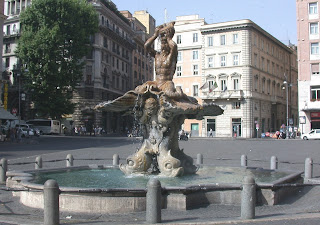 |
| Bernini's Fontana del Tritone in Piazza Barberini is one of the sculptor's many famous works in Rome |
But then came the war against Odoardo Farnese, the Duke of
Parma, which some historians blame on his nephews.
The conflict was rooted in a quarrel over questions of
etiquette during the Duke’s visit to Rome in 1639. In revenge, the nephews persuaded Urban
to ban the export of grain from Castro, an ancient city controlled by the
Farnese family in what is now northern Lazio, to the Papal States.
This deprived Farnese of an income he needed to pay the
interest on his borrowings. The Duke's creditors complained to the pope, who
took forcible possession of Castro in order to assure the payment. When the Duke
still failed to meet his debts, Urban excommunicated him and deprived him of
all his fiefs.
What Urban VIII had not foreseen was that the Farnese would
enlist the support of Tuscany, Modena, and Venice in raising an army of about 3000
horsemen, who put the papal troops to flight. When Urban refused to accept
proposed peace terms, hostilities were renewed and continued until the pope
finally conceded defeat in March, 1644.
By then the debts of the Papal States had grown so huge that
80 per cent of their annual income was spent on paying the interest alone.
Urban VIII died disliked and in disgrace, his achievements
as pope, such as denouncing the slave trade in the West Indies and Brazil,
clearing the way for Jesuit missionaries to travel to South America, China and
Japan and banning the use of tobacco in holy places – a decree that was
repealed 100 years later – not given the recognition they deserved.
His tomb, sculpted by Bernini, is in St Peter’s Basilica.
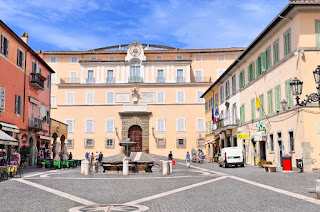 |
| The papal palace at Castel Gandolfo opens on to the town's main square, Piazza della Libertà |
Travel tip:
Visitors to the town of Castel Gandolfo in the Alban Hills,
overlooking Lago Albano in the area known as the Castelli Romani, can now go
inside Urban VIII’s 17th century papal palace, which ceased to be a
papal residence in 2016 at the behest of the incumbent Pope Francis, ending its
centuries’ old role as the summer retreat for the pontiff. Built on the site of what was once the
residence of the Roman emperor Domitian, the palace was designed for Urban VIII
by the then architect of St Peter’s, Carlo Maderno.
 |
| Tortellini are said to be shaped to represent a female navel |
Travel tip:
Castelfranco Emilia is a town just to the east of Modena,
straddling the ancient Via Emilia, the Roman road that ran from Piacentia (now
Piacenza) to Ariminum (now Rimini) on the Adriatic coast. It is said to be the
home of tortellini, the stuffed pasta supposedly created by an innkeeper to represent
the navel of a female guest with whom he was particularly taken and whom he had
spied upon while bathing.






